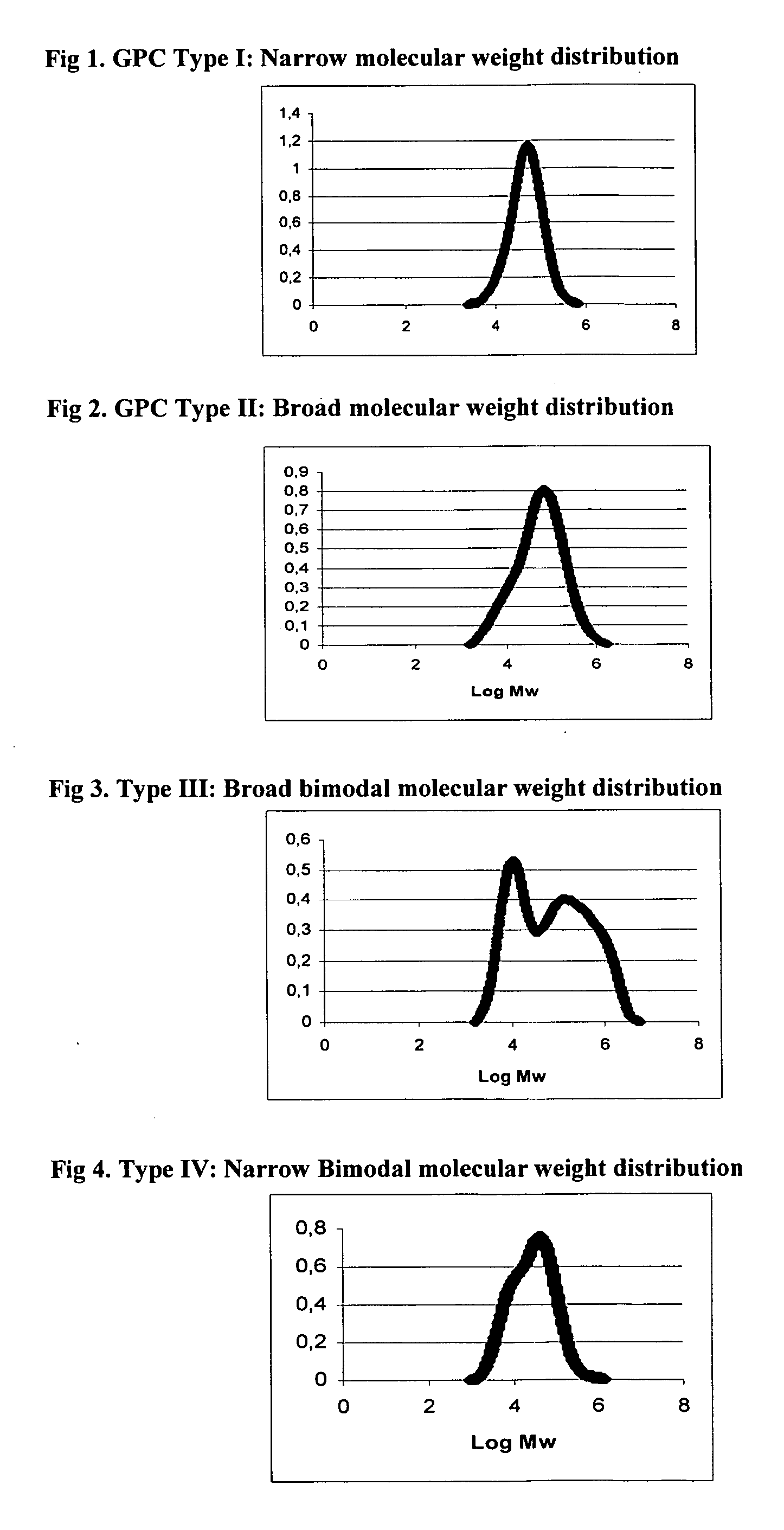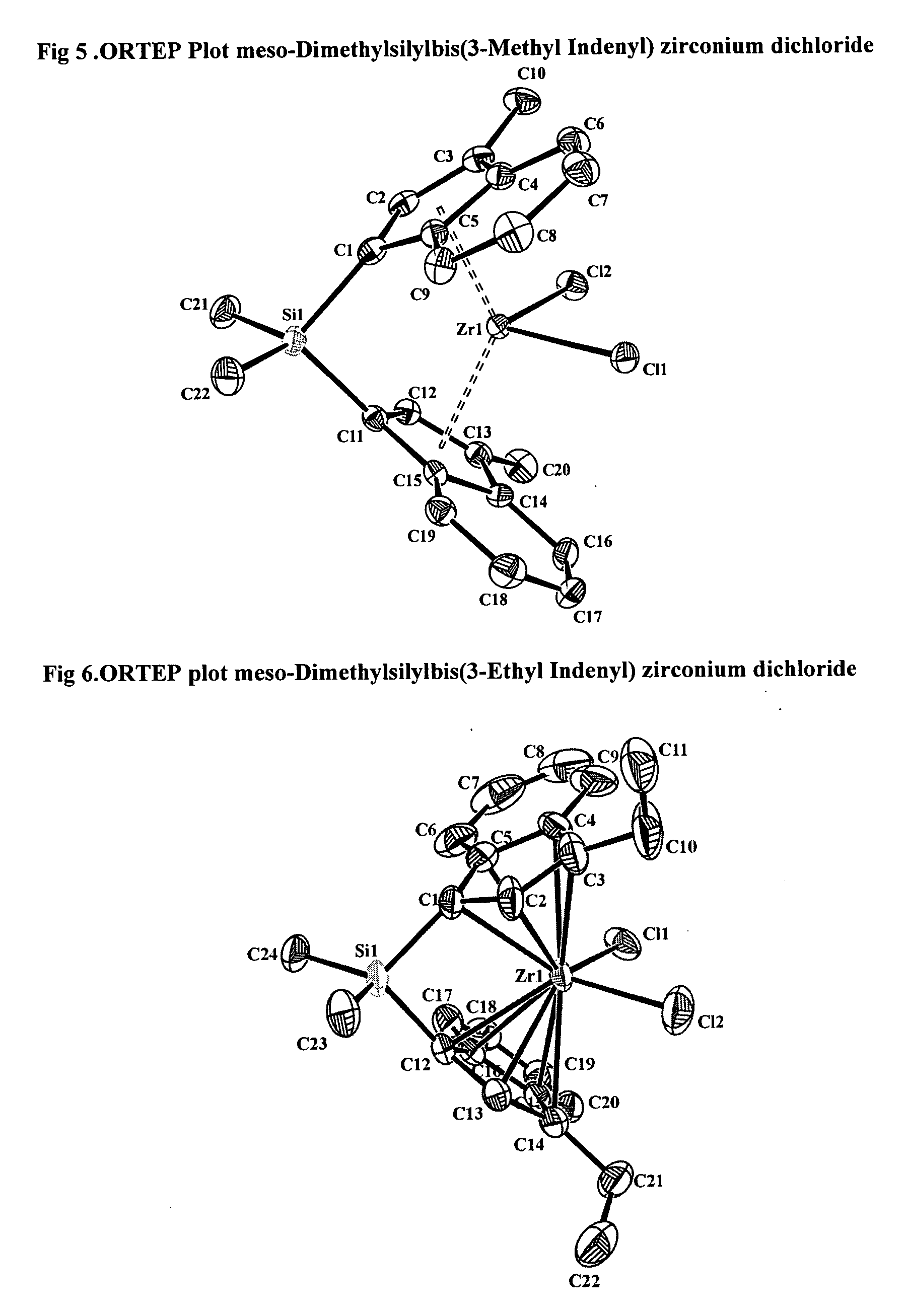Catalysts compositions for the polymerization and copolymerization of alpha-olefins
- Summary
- Abstract
- Description
- Claims
- Application Information
AI Technical Summary
Benefits of technology
Problems solved by technology
Method used
Image
Examples
example 1
Preparation of Meso-[Zr{Me2Si(3-CH3-(η5-C9H5))2}Cl2]R═CH3 (11)
[0240] [Me2Si(3-CH3—C9H6)2] (5.00 g, 15.80 mmol) was disolved in Et2O (100 ml) and nBuLi (1.60 M in hexane) (23.70 ml, 37.92 mmol), was dropwise added at −78° C. under stirring. After the addition was completed temperature was slowly raised until room temperature was reached and the reaction mixture mantained under stirring during 4 hours more yielding a yellow suspension of the dilithium salt. To a −20° C. sitirred and cooled ZrCl4 suspension in toluene (3.69 g, 15.80 mmol) (50 ml toluene), the dilithium salt suspension previously prepared was portionwise added and temperature kept after addition is finished during 30 minutes. Temperature was allowed to raise to room temperature and the reaction mixture stirred for 15 additional hour. A yellow-brown suspension is finally obtained. All solvents were removed in vacuo and CH2Cl2 (300 ml) added to the residue, the suspension formed is filtered through dry Celite and the fil...
example 2
Preparation of Rac and Meso Isomers of [Zr{Me2Si(3-CH3CH2-(η5-C9H5))2}Cl2] (12)
[0243] Synthesis of compound (12) was carried out in a similar manner as that of (11) using the following reagents: [Me2Si(3-R—C9H6)2]R═CH2CH3 (5.00 g, 14.03 mmol), nBuLi (1.60 M in hexane) (21.05 ml, 33.67 mmol) and ZrCl4 (3.27 g, 14.03 mmol). Yield (30%).
[0244] Compound (12) was isolated as a mixture of racemic and meso isomer and being identified by their 1HNMR spectra.
[0245] Two samples with different proportion of isomeric rac:meso proportions were isolated: 9:91 and 50:50.
δ(ppm) Meso isomerδ(ppm) Rac isomerH1.10(s, 6H)Si(CH3)20.91(s, 3H)Si(CH3) (exo)1.36(s, 3H)Si(CH3) (endo)1.21(t, 6H)1.11(t, 6H)—CH2CH32.80(m, 4H)2.75(m, 4H)—CH2CH35.62(s, 2H)5.82(s, 2H)H2 indene ring6.92, 7.18(dd, 1H)7.05, 7.31(dd, 2H)H5, H6 indene ring7.45, 7.48(d, 1H)7.45, 7.48(d, 2H)H4, H7 indene ring
[0246] Suitable crystals of the meso isomer were grown and the crystal structure determined by X Ray difraction. ORTEP diagram...
example 3
Preparation of Rac / Meso [Zr{Me2Si(3-CH3CH2CH2-(η5-C9H5))2}Cl2] (13)
[0247] Synthesis of compound (13) as a rac / meso mixture of stereoisomers was carried out in a similar manner as that of (12) using the following reagents: [Me2Si(3-R—C9H6)2]R═CH2CH2CH3 (5.00 g, 14.03 mmol), nBuLi (1.60 M in hexane) (21.05 ml, 33.67 mmol) and ZrCl4 (3.27 g, 14.03 mmol). From the yellow-brown suspension obtained after reaction was completed ethyl ether was removed in vacuo the toluene solution was filtered trough Celite and the retained residue washed with additional toluene (250 ml). Evaporation of toluene from the filtrate yields an orange crystalline solid identified as a mixture of rac and meso isomers of (11) (26% yield) by 1HNMR analysis. Desired compound was isolated as a 59:41 rac:meso mixture.
δ(ppm) Meso isomerδ(ppm) Rac isomerH1.25(s, 6H)Si(CH3)21.04(s, 3H)Si(CH3) (exo)1.51(s, 3H)Si(CH3) (endo)1.03(t, 6H)1.07(t, 6H)—CH2CH2CH31.74(m, 4H)1.65(m, 4H)—CH2CH2CH32.98(m, 4H)2.84(m, 4H)—CH2CH2CH35...
PUM
| Property | Measurement | Unit |
|---|---|---|
| Fraction | aaaaa | aaaaa |
| Chemical shift | aaaaa | aaaaa |
| Molecular weight | aaaaa | aaaaa |
Abstract
Description
Claims
Application Information
 Login to View More
Login to View More - R&D
- Intellectual Property
- Life Sciences
- Materials
- Tech Scout
- Unparalleled Data Quality
- Higher Quality Content
- 60% Fewer Hallucinations
Browse by: Latest US Patents, China's latest patents, Technical Efficacy Thesaurus, Application Domain, Technology Topic, Popular Technical Reports.
© 2025 PatSnap. All rights reserved.Legal|Privacy policy|Modern Slavery Act Transparency Statement|Sitemap|About US| Contact US: help@patsnap.com



